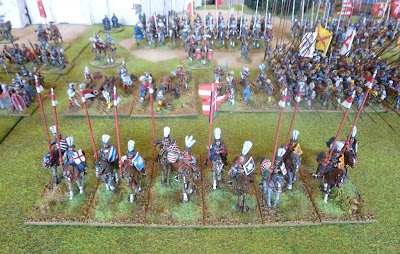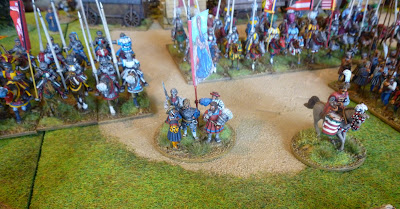Here are the early 16th century Hungarians I have been working on for the past few months. The photos of this army make a fitting post for the 10 year anniversary of the blog as they include figures that I have only just finished working on alongside figures from the first Camisado post in 2011,
http://camisado1500s.blogspot.com/2011/05/descent-into-italy.html. When I started the blog I was wondering if I could manage at least one post a month for a decade and he we are 10 years later. I guess blogging is already obsolete as a popular form of media but there are still endless scenarios to game and units to try and recreate so hopefully a few posts still to come.
The army is a combination of The Assault Group, Perry, Steel Fist, Pro Gloria (now sold by Warlord), Eureka, Wargames Foundry and Old Glory figures although there are a few other manufacturers here and there. The pavise infantry and hussars have been heavily converted but many of the other units have also had head swaps or other changes. It's an interesting army combining some of the early 16th Century favourites, such as the landsknecht and gendarmes, with more unique and unsual troop types such as the Bohemian infantry, Hussars, Horse Archers and Balkan auxiliary cavalry. Hopefully one day a figure manufacturer will make a dedicated range. Of course there are other units I would like to add, converting some Wallachian horsemen with tall fur hats would be fun. I never consider any of my collections as complete.
With regards the landsknecht I have been searching for sources confirming how many were actually at Mohacs in 1526 and how widely they were employed by the Jagiellonians. From what I have been able to find if there were any they were probably in small numbers. Oman, a dated source I know, states that at Mohacs there were 5,500 veteran foreign mercenaries but doesnt state where they were from. Tamás Pálosfalvi's "From Nicopolis to Mohács A History of Ottoman-Hungarian Warfare, 1389–1526" states that the majority of the Hungarian infantry of this era "
were not
Swiss- or Landsknecht-type infantry armed with pikes and halberds" which does make me wonder whether landsknecht pike blocks in the Hungarian army of this period are something of a "wargamer myth"? Gyozo Somogyi's "The Army of King Matthias 1458-1526", which has been a great source of pictorial inspiration for this army, includes a couple of landsknecht amongst the colour plates but as this is purely a book of images gives no further details. I would be interested to know how common landsknecht really were in the Hungarian forces of the 1520s?
The photos are all below. It's an army that when I started this blog a decade ago I never imagined I would attempt to collect. Over the past 10 years the blog has covered early 16th Century Spanish, Imperialist, French, Venetian, Scots, English, Irish, Ottoman and Papal armies as well as various rebel forces that have often been a feature in the wargame write ups. I think some interesting peasant forces to game Tudor rebellions and the German Peasants War could be a future avenue to explore along with building up my Gaelic Scots and Irish to a level where I can stage refights of battles like Knockdoe, Glentaisie and Farsetmore. More units to cover the Hungarian and Ottoman border wars offer plenty of further scope for exploration as well. It never ends does it! Thank you to everyone who has commented and supported Camisado and here's to another 10 years!






















As usual a feast for our eyes...Truly superb!
ReplyDeleteCheers Phil, its been a fun project.
DeleteThat is superb looking army - many congratulations 👍. So much eye candy there but the pavises are particularly nice.
ReplyDeleteI agree on the pavises. Brilliant!
DeleteThank you, yes those pavises are a superb shortcut and really look the part.
DeleteCongratulations on 10 years - I look forward to seeing what you produce over the next 10!
ReplyDeleteCheers Styker, I have a few ideas of new projects to work on.
DeleteA very colorful and inspirational force. I learned of history as well. Fallowing this build.
ReplyDeleteThank you, it has been unusual army to work on.
DeleteIt never ends mate but we’re with you all the way on the journey. You’re a great source of inspiration and encouragement Oli, here’s to another decade
ReplyDeleteCheers Stuart, who knows what obscure skirmishes and battles we have yet to try out. Funny that I managed to get the exact date of when I published my first post wrong!
DeleteIt is an absolutely wonderful army. So colourful and full of lovely details.
ReplyDeleteThank you Carole, there is a lot of variety in this army!
DeleteWhat a fantastic project, and congratulations on the anniversary. I think blogs are best as a sort of diary - a chance to look back, and see what you've done.
ReplyDeleteThank you, I agree the blog is great as a sort of diary. I find it a really useful way of recording my units and wargames, it gives a lot of focus to each little project.
DeleteCongrats on the blog anniversary. Wow what an amazing looking army!
ReplyDeleteThank you Peter, quite a different renaissance army the Hungarian forces.
DeleteSuperb looking army, Oli! Congratulations on ten years of blogging. The media will only become obsolete if we allow it.
ReplyDeleteCheers Jonathan, I still enjoy using the blogging format, it gives me time to put my ideas together.
DeleteCongratulations on the decade of blogging and army building! Always worth stopping by.
ReplyDeleteCheers Ross, hopefully a few more armies to come yet.
DeleteA splendid array of fighting chaps! Congratulations on 10 years of blogging! Here's to the next 10 and beyond!🥂
ReplyDeleteCheers David, surely I can ramble on about early 16th century warfare for another 10 years!
Delete10 years is a serious date! Congratulations! 8)
ReplyDeleteCheers Klingula, there have been 178 posts so far.
DeleteMy lord, that host is most impressive. You are such a superb painter. Congrats on the decade of blogging, I've always been a big fan of your posts. (And jealous of your painting skills :)
ReplyDeleteThank you Joseph, I think trying to get the feel of the armies is the most important thing for me, there is definitely plenty of room for improvement with my painting.
DeleteCongratulations, both for your blog and your army!
ReplyDeleteAnswer to your question: We know that there were landsknecht soldiers at Mohács. But only a few compared to the whole infantry. Approximately a battalion of landsknechts stationed at the Hungarian camp already. According to a source, another 300 of them joined the army a day before the battle (August 28). However most soldiers of the heavy infantry were not pikemen, but Czechs, Poles and the troops of the towns from Upper Hungary - armed with pavises and halberds.
Landsknecht became a common sight in Hungary after the battle of Mohács, when a civil war started between the suporters of the two successors (Habsburg Ferdinand and János Szapolyai). Obviously the landsknechts fought on Ferdninand's side. Also they had major battles with the Ottomans (eg. Buda 1541) and were stationed in the border castles in Hungary.
Thank you Der Hauptmann.
DeleteThat is very interesting. So as suspected there probably weren't many landsknecht at Mohacs, and in the border conflicts before. By a battalion would you mean a fahnlein so possibly 500 to 1000 Landsknecht before the other 300 joined?
I am aware that once Ferdinand becomes heavily involved in Hungary, following Louis II's death, then the Habsburg faction put the landsknecht to lots of use in Hungarian conflicts. The battles of Tarcal and Szina are ones I am keen to play scenarios of as well as the abortive siege of Buda in 1541. If you can point me to any good sources in English I would be very grateful.
I am also playing a scenario based on Szávaszentdemeter in 1523 very soon - where some of this army will form Istvan Bardis hardened border troops!
Yes, I was refering to a Fähnlein.
DeleteSadly I couldn't find any English sources on the battles of Tarcal and Szina (except Wikipedia). This is a writing about the battle os Szávaszentdemeter:
https://www.hungarianottomanwars.com/1490-1541/the-battle-of-szavaszentdemeter-1523/
Cheers Der Hauptmann, I will be interested to know what you think of the Szávaszentdemeter game when I post it up on the blog.
DeleteCongratulations for keeping up such a beautiful source of info fir such a long time. I’m always happy to see your well reserved and nicely painted armies.
ReplyDeleteI wish you at least another decade of the hobby! 😊
Cheers Ratmaul - still plenty of topics to cover!
DeleteWow, what a magnificent display of beautiful figures/units!
ReplyDeleteRegards, James
Thank you James.
DeleteThis comment has been removed by the author.
ReplyDeleteStunning army, beautiful! And no, blogging is not dead, very much alive, just doesn't get the same status as that other branch of social media ;) What's the next project? And Keep up the excellent work and thank you for sharing your artistry. :)
ReplyDeleteI'm going to correct myself. It is more than stunning, it's an inspiring work of art.
ReplyDeleteThank you, currently on the workbench are some more Irish Cavalry for my 16th century Irish stuff. I also have some games lined up so there should be some battle reports up soon.
DeleteOli, I must concur with everyone else. A truly gorgeous and varied army, and not an easy one to collect. Congratulations on 10 years of superb blogging as well. I much prefer the blog format to YouTube channels and the like, although they have their uses as well.
ReplyDeleteCheers Peter, it's been fun working on an army that is quite unique - I think that for miniatures the blog format is still a really good one to use.
DeleteCongratulations on your 10th anniversary and on this beautiful army. A truly magnificent array!
ReplyDeleteI agree with others about the continuing relevance of the blog. I certainly get a lot of inspiration and enjoyment of your and other wargaming/collecting/wargaming blogs. Long may it last.
PS: I recognise some of the heraldry on the pavisses, but not the white city/castle on blue background. It is similar to Prague and Pressburg/Pozony (Bratislava) but they are on a red field. Does this represent a city and if so, which one? Looks great either way.
ReplyDeleteThank you Centenary, I am glad you have found it useful.
DeleteThe transfers are all from here: https://1stcorps.co.uk/product-category/flags-decals/flags-decals-little-bigmen-studios/flags-decals-little-bigmen-studios-medieval/
They are designed for the Hussite Wars of the earlier 15th Century. If you have a look at my blog post before this one I went back and forth over whether to use them but when I realised that Bohemians made up a sizeable part of the Hungarian Infantry, the Jagiellonian monarchs also being Kings of Bohemia, I decided to use them. The one you are talking about is described in Ian Heath's Armies of the Middle Ages Volume 2 as "the Taborite symbol with a white castle with open gates" so it looks to represent a more radical part of the Hussite movement. Oddly the transfers also include the town of Tabor coat of arms the one in yellow with two white towers with the imperial eagle and Bohemian crest behind but the one Heath is referring to looks just like the the white city/castle on blue background that you are referring to.
Thanks for the prompt reply Oli. I have Heath's book. One of my areas of interest is urban militias in this period. I'll look into this. The sticker really is great.
Delete